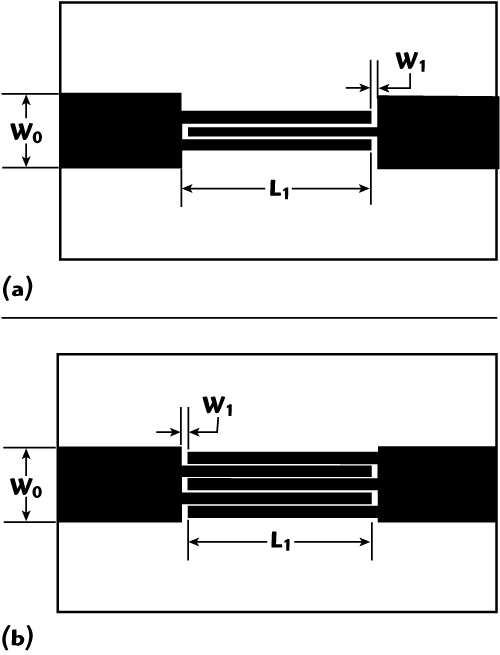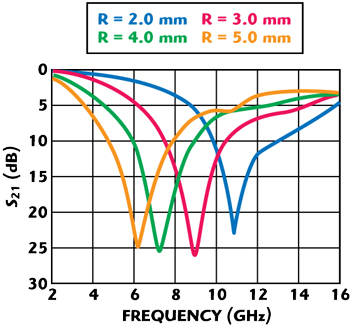Research into ultra-wideband technology has risen dramatically since the US Federal Communications Commission (FCC) authorized the frequency band of 3.1 to 10.6 GHz for commercial purposes.1 A bandpass filter is a key component of a UWB wireless communication system. Many BPFs have been developed based on various kinds of methodologies, such as non-periodical shunt-stub loading,2 composite low pass/high pass topology,3 cascaded broadside-coupling,4 circular resonator5 and multiple-mode resonator (MMR).6-9 Most of these BPFs have good in-band frequency performance, but the out-of-band performance is poor. Due to the existing radio signals such as wireless local-area network (WLAN) signals, which may interfere with the UWB users, a small BPF with a notched band is needed to reject these interfering signals. A UWB BPF with a notched band was realized using an embedded open-circuited stub,10 which is an effective way to reject any undesired radio signal. However, this structure has poor out-of-band performances.
In this article, a novel UWB BPF is proposed and implemented. It exhibits good frequency performances and a highly rejected notched band in the passband and achieves a wide stopband. The designed UWB BPF consists of two cascaded interdigital hairpin resonator units and four semicircle defected ground structures (S-DGS) along with the microstrip line. This structure is simple and flexible for the purpose of blocking any unwanted existing radio signals that may appear in the UWB band. S-DGSs are used to improve out-of-band performances. Measured results agree well with the simulated results.
Analysis and Design
Interdigital Hairpin Resonator

Figure 1 Geometry of interdigital hairpin resonators: (a) 3 fingers and (b) 5 fingers.

Figure 2 Simulated S-parameters of the hairpin resonator unit.
Figure 1 shows the geometry of a conventional interdigital hairpin resonator unit with three identical fingers within a 50 Ω microstrip line. The width of the finger is W2 and the distance between the adjacent coupling fingers is W3. The microstrip interdigital hairpin resonator proposed in this article, with five identical fingers, is also shown. The coupling-finger length (L1) is first chosen to be one-quarter wavelength at the center frequency of this UWB passband, which is 6.85 GHz. The frequency characteristics of these two interdigital hairpin resonators are simulated by HFSS V.10.0. The simulation results show that a notched band is introduced by adding two fingers, as shown in Figure 2, where W0 = 3.0 mm, W1 = 0.15 mm, W2 = 0.4 mm, W3 = 0.15 mm, L1 = 9.4 mm, substrate εr = 2.2 and the substrate thickness is 1.0 mm. Different notched bands can be achieved by changing W2 and W3. However, it can be seen that the proposed interdigital hairpin resonator unit has a gradual cut-off frequency response and poor out-of-band performance.
Semicircle Defected Ground Structure

Figure 3 Geometry of the proposed S-DGS unit
A defected ground structure (DGS) for a microstrip line is a periodic defect etched in the ground plane, which can provide a good band-rejection property. The conventional dumbbell DGS consists of two rectangular defected areas and one connecting slot on the backside metallic ground plane. The configuration of the proposed S-DGS, fed by a 50 Ω microstrip line, is shown in Figure 3. It consists of two semicircle defected areas and one narrow connecting slot on the ground plane of the microstrip line. The new S-DGS has better stopband characteristics.

Figure 4 Equivalent circuit of the proposed S-DGS unit.
The frequency characteristic of the S-DGS unit can be modeled by a series-connected parallel LC resonance circuit in the transmission line, as shown in Figure 4. The equivalent capacitance and inductance of the circuit can be extracted by using the circuit analysis theory as follows:

where ƒc is the 3 dB cut-off frequency and ƒ0 is the resonant frequency of the stopband.

Figure 5 Simulated S21 of the proposed S-DGS unit for various semicircular radius.

Figure 6 Simulated S21 of the proposed S-DGS unit for various gap distances.
Furthermore, the effects of the proposed S-DGS parameters on the frequency characteristics have been investigated. Figure 5 shows the transfer characteristics of the S-DGS with a different radius with W0 = 3.0 mm and W1 = 0.4 mm. The simulation results show that the cut-off frequency is dependent on the radius of the semicircle. As the radius is increased, the cut-off frequency decreases. Figure 6 shows the frequency response of the S-DGS for various gap distances with W0 = 3.0 mm and R = 4.0 mm. It can be seen that the resonance frequency is proportional to the gap distance.
UWB BPF

Figure 7 Geometry of the proposed UWB BPF.
For the design of a UWB BPF with a highly rejected notched band and good frequency characteristics in passband and stopband, two interdigital hairpin resonator units and four S-DGSs are cascaded along with the microstrip line. S-DGSs are on the backside metallic ground plane under the microstrip line. The configuration of the proposed UWB BPF is shown in Figure 7. Different notched bands can be obtained by changing W2 and W3. The BPF simulation is performed by using HFSS V.10.0. The substrate is RT/Duroid 5880 with a thickness of 1.0 mm and a dielectric constant of 2.2. All the dimensions are determined as follows: W0 = 3.0 mm, W1 = 0.4 mm, W2 = 0.4 mm, W3 = 0.15 mm, W4 = 0.1 mm, L1 = 7.2 mm, L2 = 5.0 mm and R1 = 1.0 mm.
Results and Discussions

Figure 8 Simulated and measured S-parameters of the designed UWB BPF.

Figure 9 Photographs of fabricated UWB BPF: (a) top view, (b) bottom view and (c) with opened metallic enclosure.

Figure 10 Measured S-parameters of the UWB BPF with and without metallic enclosure.
Finally, the designed UWB BPF is measured with an Agilent N5230A vector network analyzer. The comparison between the simulated and measured results is shown in Figure 8. It is found that the working frequency of the proposed UWB BPF is 3.1 to 10.6 GHz and the notched band is 7.5 to 7.6 GHz. The insertion loss is less than 1.0 dB and the return loss is better than 10 dB in most part of the passband. The measured rejection loss is more than 25 dB at the mid-band frequency of the notched band and the upper-stopband with 20 dB attenuation is up to 20 GHz. It is found that the measured lower corner frequency is shifted to a higher frequency, which could be attributed to the fabrication tolerance. Figure 9 shows photographs of the fabricated UWB BPF. The volume of the UWB BPF with the metallic enclosure is 36 × 29 × 22 mm. In consideration to the application, the influence of a metallic enclosure on the S-parameters of the proposed UWB BPF has also been analyzed, as shown in Figure 10. By observing the figure, one can find that the influence is weak and the insertion loss at the upper-stopband is slightly increased but still is less than 10 dB, which can be neglected when the proposed BPF is applied to a UWB system.
Conclusion
In this article, a compact UWB BPF with a highly rejected notched band and improved out-of-band performance has been proposed, designed and implemented. By using two cascaded interdigital hairpin resonator units and introducing four S-DGSs, the proposed UWB BPF can have a wide stopband and in the meantime effectively introduce a narrow notched band. The measured results are in good agreement with the simulated results.
References
1. Federal Communications Commission, “Revision of Part 15 of the Commission’s Rules Regarding Ultra-wideband Transmission Systems,” Cover Report ET-Docket 98–153, FCC02–48, April 2002.
2. J.S. Hong and H. Shaman, “An Optimum Ultra-wideband Microstrip Filter,” Microwave and Optical Technology Letters, Vol. 47, No. 3, March 2005, pp. 230-233.
3. W. Menzel, M.S.R. Tito and L. Zhu, “Low-loss Ultra-wideband (UWB) Filters Using Suspended Stripline,” 2005 Asia-Pacific Microwave Conference Proceedings, pp. 2148-2151.
4. K. Li, D. Kurita and T. Matsui, “An Ultra-wideband Bandpass Filter Using Broadside-coupled Microstrip-coplanar Waveguide Structure,” 2005 IEEE International Microwave Symposium Digest, pp. 675-678.
5. J.K. Xiao and Y. Li, “Novel Compact Microstrip Square Ring Bandpass Filters,” Journal of Electromagnetic Waves and Applications, Vol. 20, No. 13, 2006, pp. 1817-1826.
6. L. Zhu, W. Menzel, K. Wu and F. Boegelsack, “Theoretical Characterization and Experimental Verification of a Novel Compact Broadband Microstrip Bandpass Filter,” 2001 Asia-Pacific Microwave Conference Proceedings, pp. 625-628.
7. L. Zhu, S. Sun and W. Menzel, “Ultra-wideband (UWB) Bandpass Filters Using Multiple-mode Resonator,” IEEE Microwave Wireless and Components Letters, Vol. 15, No. 11, November 2005, pp. 796-798.
8. L. Zhu and H. Wang, “Ultra-wideband Bandpass Filter on Aperture-backed Microstrip Line,” Electronics Letters, Vol. 41, No. 18, September 1, 2005, pp. 1015-1016.
9. H. Wang, L. Zhu and W. Menzel, “Ultra-wideband (UWB) Bandpass Filters with Hybrid Microstrip/CPW Structure,” IEEE Microwave Wireless and Components Letters, Vol. 15, No. 12, December 2005, pp. 844-846.
10. H. Shaman and J.S. Hong, “Ultra-wideband (UWB) Bandpass Filter with Embedded Band Notch Structures,” IEEE Microwave and Wireless Components Letters, Vol. 17, No. 3, March 2007, pp. 193-195.
